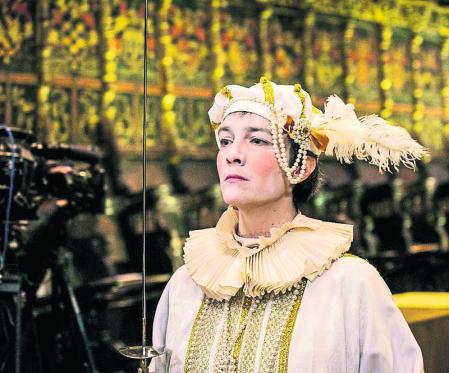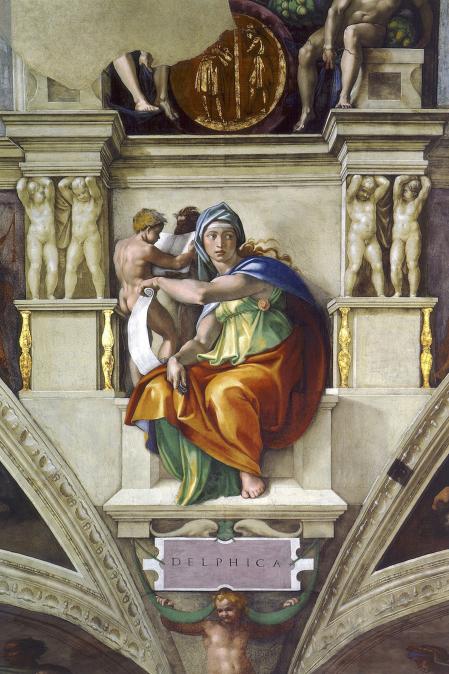Bell upon bell, and upon bell one, take a look… at the Song of the Sibil la. Because traditions come back if they have ever left and the representations of The song of the Sibil la They multiply, both in their most classical form and in the most contemporary ones, which look to the Greco-Roman past with one eye and the technological future with the other.
But where does the myth come from? According to him Dictionary of Greek and Roman mythology by Pierre Grimal (Paidós/Edicions de 1984), a sibyl is “a priestess in charge of making known the oracles of Apollo”. Women endowed with the prophetic gift, for which they were respected and listened to. In the book Quan sings the Sibil la (Vienna publishing house, 2021), by Antoni Gelonch and Oriol Pérez Treviño, it is explained that the first to mention it was Heraclitus of Ephesus (5th century BC), according to who pronounces “through the god, with his frantic mouth, things that are not to laugh, without decorations and without perfume”.
According to Heraclitus, the Sibyl says “things that are not to laugh, without decorations and without perfume”
Was there one or were there several? The number oscillates according to the era, at times only one is mentioned, and in Hellenistic times there are nine, but in Roman times the Tiburtine Sibyl is added, and “at the end of the Middle Ages, the number of sibyls will be extended to twelve, perhaps in order to equate them to the number of apostles”.
Gelonch explains in the book that “the sibylline oracles spoke of a king who had to introduce the kingdom of God among humans, and that all peoples would finally recognize the law of God”, so “Christianity linked this tradition to the figure of the Messiah and the Church assimilated the character of the sibyl until turning it into an element of liturgical representation”. Christianity, for example, reinterpreted the oracles of the Tiburtine Sibyl about the future of Rome as the arrival of the end of the world, the second coming of Christ, the Last Judgment. The sibyls as a pagan and feminine counterpoint to the prophets: “They were soon included as characters in Christian ceremonies, especially in the winter solstice festivities, Christmas.”
Michelangelo’s Delphic Sibyl in the Sistine Chapel
The literary base on which the song is based is a fifth-century poem in Latin, iudicii signumof Saint Quodvultdeus, included in a sermon with apocalyptic resonances with a prediction by the Sibyl.
Around the year one thousand we find the first traces written with musical notation, which became popular as a result of the apocalyptic fear of the turn of the millennium, between bad harvests, wars and diseases, in a liturgical drama that at the end of the 13th century began to be sung in vernacular languages. In Catalan, its spread seems to have been linked to the outbreak of the Black Death in 1348.
read also
In the Middle Ages, Christianity assimilated them as a pagan and feminine counterpoint to the prophets.
The Song of the Sibil la Properly speaking, it was profusely represented in various versions throughout the Catalan-speaking territories until the Council of Trent (1545-1563) approved a provision that said that in a mass “the sung text must be intelligible and must not distract to the faithful of attention to the divine mystery”. In numerous places, such as Barcelona, the Song of the Sibil la. On the island of Majorca and in l’Alguer, on the other hand, Christmas Eve continued to be performed without interruption.
At the end of the 20th century, the phenomenon began to become popular, and Pérez Treviño attributes it in part to the recording made by the Ars Musicae group and, later, by Jordi Savall’s Capella Reial, as well as by Maria del Mar Bonet. In Barcelona it was first recovered in the church of Santa Maria del Mar in 1983, from where it spread to other churches until in 2009, 434 years after its last performance, it returned to the Barcelona cathedral, in a historicist version of the hand of the Cor de Cambra Francesc Valls. The cathedral now commissions a contemporary composer each year to write a small piece, which has been written by Jordi Cervelló, Bernat Vivancos or Joan Magrané, among others. In 2010, Unesco declared the song intangible heritage of humanity.
Ars Musicae, Jordi Savall and Maria del Mar Bonet popularized this music among today’s public
So is it fashionable today? The composer Joan Magrané is convinced that it is, “because even though it is outside of dogma, it maintains a spirituality and ritualism that links with magic and is deeply rooted in the Mediterranean.” For the anthropologist and writer Adrià Pujol Cruells, it is an “attractive phenomenon (more than so many other things in tradition) because it preserves something very Hollywood, which is almost Marvel, that is, iconography of monsters and mystery, and pop culture needs to”. In addition, he says, “the baroque returns, and the Sibyl fits him like a glove.”
In fact, some celebrations, like the one Maria Arnal gave to the church of San Felip Neri, are devoid of the religious layer and become a great collective catharsis for the solstice. “May the Sibyl give us her revelations!” The artist asked in full concert. Arnal, in addition, had done with the poet Eduard Escoffet and José Luis de Vicente –new director of the Museu del Disseny– the performative conference thousand sibyls, originating from the CCCB but which has been performed in other places such as Madrid or Mallorca. For Escoffet, who for years has also been giving an introduction to Mariona Segarra’s singing in the church of Santa Maria del Pi, the Sibyl reveals a secret that is not: it is not the world that is sinking, but our civilization, and that is why he questions us.

Rehearsal of ‘El cant de la Sibil la’ in Barcelona Cathedral in 2021
The master organ builder Albert Blancafort, production director of the performance on January 1 in the caves of Montserrat, believes that beyond Catholicism “the sibyls are semi-divine beings who make people aware that if we do not act, we already have the Apocal ipsis above”.
And today, someone has the role of the Sibyl? Both Magrané and Blancafort assure that an activist like Greta Thunberg can play this role: “It warns and bothers”.
Christmas Eve and New Years
Where to see ‘El cant de la Sibil la’ these days
Santa Maria del Mar. The first to be recovered in Barcelona, in 1983. 7:30 p.m.
Sagrada Família Crypt. It will be performed for the first time, with the soprano Laia Nomen. 7:30 p.m.
Barcelona’s cathedral. With the mezzo-soprano Mariona Llobera and the Choir Francesc Valls. This year they have commissioned a piece from the composer Antoni Ros Marbà. 10:30 p.m.
Santa Maria del Pi. Mariona Sagarra, Joan Cabó on the organ and an introduction by the poet Eduard Escoffet. 11:30 p.m.
Cathedral of Santa Tecla of Tarragona. With Marta Mathéu and organ accompaniment. After the midnight mass.
Majorca. This year, in the 115 parishes of the island. The one at the Lluc sanctuary (7:00 p.m.) and the one at the Palma cathedral (11:00 p.m.) stand out.
Montserrat caves, on January 1. With the soprano Kiani Vilar and the Choir Francesc Valls, with Juan de la Rubia on organ and Gener Salicrú on clarinet. With new texts and pieces by Bernat Vivancos and Joan Magrané. It is done in a cave because it was in a cave where the ancient Sibyl of Cumes made her predictions. January 1, 2023 at 7:00 p.m.

